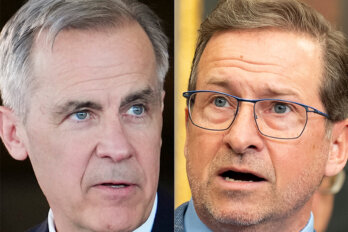I’m old enough to remember the 1997 federal election, when Jean Chrétien led his Liberals to a second majority government. As early results trickled in, however, it soon became clear that the Liberals were being routed on the East Coast. While Conservatives eked out a victory in many seats, the story in Atlantic Canada that evening belonged to Nova Scotia’s Alexa McDonough. The new federal NDP leader rode a wave of local fury at Liberal changes to the employment insurance program to pick up eight seats in the Atlantic provinces, including a majority of seats in Nova Scotia. At long last, the New Democratic Party had broken through the region in dramatic fashion. Halifax would remain an NDP fortress for nearly two decades.
Fast forward to 2015: I was gathered with friends in the South End of Halifax for a boisterous election-night watch party. Although the NDP under Thomas Mulcair began the 2015 campaign polling at 40 percent by one estimate, Justin Trudeau’s Liberals romped to victory on the back of anti-Conservative sentiment and Trudeau’s so-called sunny ways. As the dust settled, the NDP was wiped off the map in Atlantic Canada. Popular MPs like Jack Harris—who won an astonishing 71 percent of the vote in St. John’s East in 2011—went down in defeat. Others who lost included Megan Leslie in Halifax—McDonough’s successor—a hard-working MP touted by many as a future leader of the party.
It’s safe to say that a decade is a lifetime in politics. When Trudeau became prime minister, Barack Obama was still president of the United States. In 2025, a second Donald Trump presidency and a still-unfolding Liberal leadership race make the upcoming federal election one of the most unpredictable in recent memory.
Until recently, polls seemed to paint a convincing picture of a Conservative sweep in Atlantic Canada—a tide that seemed to threaten even ridings that have reliably voted Liberal since the 1980s. With Trudeau’s resignation in early January and a new government south of the border, the picture is now more complicated.
What’s certain is that any hope for NDP gains in this year’s federal campaign rest on former NDP strongholds, like Halifax and St. John’s. As results trickle in on election night 2025, all eyes will be on these ridings.
Mary Shortall is the kind of candidate any party would dream of. I spoke to her after she’d just returned from an event marking one of the most vital days of remembrance in Newfoundland and Labrador—the anniversary of the gut-wrenching Ocean Ranger disaster, which saw eighty-four workers killed when an offshore oil rig sank in a violent winter storm in 1982.
Shortall is a four-decade veteran of the labour movement, former president of the Newfoundland and Labrador Federation of Labour, and current president of the federal NDP. She’s also the party’s candidate for St. John’s East, Jack Harris’s old riding. Like Shortall, Harris was a plainspoken, much-admired activist, a star candidate with great local name recognition. Shortall ran in the last federal election, finishing a strong second to Liberal Joanne Thompson, the federal minister of seniors since last December.
While acknowledging the Liberals’ historic strength in Atlantic Canada, Shortall says she’s hearing fear and disappointment at the doors these days. Newfoundlanders are feeling squeezed economically amidst rising inflation, housing insecurity, and cost-of-living increases.
In the past few elections, the fight in St. John’s East has been a two-way horse race between the Liberals and the NDP. Shortall believes disenchantment with the Liberals means the choice this time is between the Conservatives and the NDP. The Conservatives have not been strong contenders in the riding for years—stretching back to former premier Danny Williams’s high-profile “Anyone but Conservatives” campaign against the Stephen Harper government over federal equalization clawbacks in Newfoundland’s booming offshore oil sector. But this time, they’ve announced David Brazil, former leader of the provincial Progressive Conservative party, as their candidate. It’s a sign of the party’s ambitions here.
Nevertheless, a dramatic rise in nationwide Liberal support since early January has been most striking in Atlantic Canada. Some recent polls indicate the federal Liberal Party approaching 50 percent in the region, a swing of nearly thirty points in a month. And that’s without a new leader announced yet. The Liberals appear to be drawing voters away from both the Conservatives and the NDP, making races like those in St. John’s impossible to predict.
“We’re in a moment of the unknown,” says political scientist Alex Marland of Acadia University, “given that we don’t know who the next Liberal leader will be.” Marland says the problem with such polls is that they are asking Canadians about a non-existent situation. A hypothetical Liberal leader is like an empty box upon which voters can project what they wish. Marland argues that the Liberals under Trudeau positioned themselves as champions of progressive social issues, shifting the Liberals’ core brand promise from defending national unity in the face of the Quebec separatist threat toward a national unity based on inclusive diversity and upholding Charter rights.
With a new leader to be selected, and in the face of American aggression, Marland sees a sharp pivot for the party back toward its foundations, once again making robust Canadian nationalism a central plank in its messaging. If Mark Carney wins the leadership race as expected, Marland says, his challenge will be to siphon off support from soft Conservative and NDP voters and solidify the Liberal base.
Marland is not overly optimistic about the NDP’s prospects in Atlantic Canada. Recent polls suggest the NDP may be shut out of the Atlantic region for the second election in a row, with the Liberals clinging on to the majority of their seats and the Conservatives making limited gains. For Marland, the fear engendered by a Trump presidency seems to have further polarized the election as a race between the Liberals and Conservatives. Amid the uncertainty, “people have not gravitated to the NDP. They’ve gone away from the NDP,” toward a re-energized Liberal Party, he says.
Part of the NDP’s challenge stems from what Marland sees as an increasing urban–rural divide in Atlantic Canada. He believes the federal NDP’s focus on progressive social policies that urban voters tend to favour, such as gun control or support for the carbon tax, can alienate rank-and-file workers and rural voters. Marland says the NDP’s best shot in the region lies in Halifax, a mostly urban riding that has not voted Conservative since the late 1980s.
In Halifax—where a federal by-election has just been called—the NDP is running Lisa Roberts, a former provincial MLA, journalist, and community organizer who came a close second to Liberal Andy Fillmore in the last federal election. Roberts was nominated early, and her team has already knocked on the doors of over half of the area’s constituents. With Fillmore now Halifax mayor, the Liberals have only recently announced a candidate. Before then, Roberts believed her main competition would come from the Conservatives. Indeed, in the recent Nova Scotia election, the Liberal vote collapsed and the provincial NDP became the official opposition, winning most of the seats within the boundaries of the federal Halifax riding.
As Roberts canvasses, she says, she’s hearing nervousness around Conservative leader Pierre Poilievre, even among older voters who have traditionally voted Conservative. Both Shortall and Roberts say that Poilievre does not represent the values of the more moderate Progressive Conservative tradition of Atlantic Canada. According to Marland, provincial PC parties in the region have a record of being socially progressive, and their policy platforms can often be remarkably similar to those of other parties (the politics of Blaine Higgs in New Brunswick being a notable exception). Former Prince Edward Island premier Dennis King, a Progressive Conservative who stepped down in late February, famously hugged his main opponent after the 2019 election and refused to align himself with the fiery resistance politics of conservative premiers from Ontario and Alberta. As Marland puts it, “Some of the things we see in the rest of the country don’t happen here.”
Both Roberts and Shortall believe local issues, like rising grocery prices, will play an important role in the next election, though Marland is clear that most federal campaigns now revolve around a strong central leader and disciplined party messaging. Another potential wild card is the surge of new residents who have recently moved to the region from other parts of the country and the world. Halifax is one of Canada’s fastest-growing cities. Most party ground games have a sense of who their supporters and potential voters are, but recent transplants from places like Ontario might throw a wrench into those projections on election day, making a difference in a tightly fought campaign.
“I try to remind myself that there’s no way to flip to the end of the book and see what happens,” Roberts says. “We’re still writing it. We’re still writing the story.”




